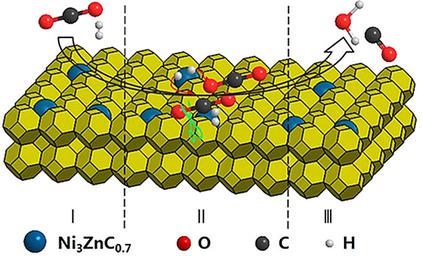当前位置:
X-MOL 学术
›
ChemSusChem
›
论文详情
Our official English website, www.x-mol.net, welcomes your feedback! (Note: you will need to create a separate account there.)
Highly Dispersed Metal Carbide on ZIF‐Derived Pyridinic‐N‐Doped Carbon for CO2 Enrichment and Selective Hydrogenation
ChemSusChem ( IF 8.4 ) Pub Date : 2018-02-28 , DOI: 10.1002/cssc.201800016 Yunhua Li,Xiaohu Cai,Sijing Chen,Hua Zhang,Kevin H. L. Zhang,Jinqing Hong,Binghui Chen,Dong-Hau Kuo,Wenju Wang
ChemSusChem ( IF 8.4 ) Pub Date : 2018-02-28 , DOI: 10.1002/cssc.201800016 Yunhua Li,Xiaohu Cai,Sijing Chen,Hua Zhang,Kevin H. L. Zhang,Jinqing Hong,Binghui Chen,Dong-Hau Kuo,Wenju Wang

|
Catalytic conversion of CO2 into chemicals is a critical issue for energy and environmental research. Among such reactions, converting CO2 into CO has been regarded as a significant foundation to generate a liquid fuels and chemicals on a large scale. In this work, zeolitic imidazolate framework‐derived N‐doped carbon‐supported metal carbide catalysts (M/ZIF‐8‐C; M=Ni, Fe, Co and Cu) with highly dispersed metal carbide were prepared for selective CO2 hydrogenation. Under the same metal loadings, catalytic activity for CO2 hydrogenation to CO follows the order: Ni/ZIF‐8‐C≈Fe/ZIF‐8‐C>Co/ZIF‐8‐C>Cu/ZIF‐8‐C. These catalysts are composed of carbide or metal supported on pyridinic N sites within the N‐doped carbon structure. ZIF‐8‐derived pyridinic nitrogen and carbide effect CO2 adsorption, whereas dispersed Ni or Fe carbide and metal species serve as an active site for CO2 hydrogenation. The supported Ni catalyst exhibits extraordinary catalytic performance, which results from high dispersion of the metal and exposure of the carbide. Based on high‐sensitivity low‐energy ion scattering (HS‐LEIS) and line scan results, density functional theory (DFT) was used to understand reaction mechanism of selective CO2 hydrogenation over Ni/ZIF‐8‐C. The product CO is derived mainly from the direct cleavage of C−O bonds in CO2* rather than decomposition of COOH*. The CO* desorption energy on Ni/ZIF‐8‐C is lower than that for further hydrogenation and dissociation. Comparison of Ni/ZIF‐8‐C with ZIF‐8‐C indicates that the combined effects of the highly dispersed metal or carbide and weak CO adsorption result in high CO selectivity for CO2 hydrogenation.
中文翻译:

ZIF派生的吡啶N掺杂碳上的高度分散金属碳化物,用于CO2富集和选择性加氢
将CO 2催化转化为化学物质是能源和环境研究的关键问题。在这些反应中,将CO 2转化为CO已被认为是大规模生产液体燃料和化学品的重要基础。在这项工作中,制备了具有高分散金属碳化物的沸石咪唑酸酯骨架衍生的N掺杂碳载金属负载的金属碳化物催化剂(M / ZIF-8-C; M = Ni,Fe,Co和Cu),用于选择性CO 2加氢。在相同的金属负载量下,CO 2的催化活性加氢成CO的顺序为:Ni /ZIF-8-C≈Fe/ ZIF-8-C> Co / ZIF-8-C> Cu / ZIF-8-C。这些催化剂由负载在N掺杂碳结构内吡啶N位上的碳化物或金属组成。ZIF-8衍生的吡啶氮和碳化物会影响CO 2的吸附,而分散的Ni或Fe碳化物和金属则是CO 2氢化的活性位。负载的Ni催化剂表现出非凡的催化性能,这归因于金属的高度分散和碳化物的暴露。基于高灵敏度低能离子散射(HS-LEIS)和线扫描结果,使用密度泛函理论(DFT)了解选择性CO 2的反应机理在Ni / ZIF-8-C上氢化。产物CO主要来自CO 2 *中CO键的直接裂解,而不是COOH *的分解。Ni / ZIF-8-C上的CO *解吸能量低于进一步氢化和解离的能量。Ni / ZIF-8-C与ZIF-8-C的比较表明,高度分散的金属或碳化物和弱的CO吸附的综合作用导致CO 2加氢的CO选择性高。
更新日期:2018-02-28
中文翻译:

ZIF派生的吡啶N掺杂碳上的高度分散金属碳化物,用于CO2富集和选择性加氢
将CO 2催化转化为化学物质是能源和环境研究的关键问题。在这些反应中,将CO 2转化为CO已被认为是大规模生产液体燃料和化学品的重要基础。在这项工作中,制备了具有高分散金属碳化物的沸石咪唑酸酯骨架衍生的N掺杂碳载金属负载的金属碳化物催化剂(M / ZIF-8-C; M = Ni,Fe,Co和Cu),用于选择性CO 2加氢。在相同的金属负载量下,CO 2的催化活性加氢成CO的顺序为:Ni /ZIF-8-C≈Fe/ ZIF-8-C> Co / ZIF-8-C> Cu / ZIF-8-C。这些催化剂由负载在N掺杂碳结构内吡啶N位上的碳化物或金属组成。ZIF-8衍生的吡啶氮和碳化物会影响CO 2的吸附,而分散的Ni或Fe碳化物和金属则是CO 2氢化的活性位。负载的Ni催化剂表现出非凡的催化性能,这归因于金属的高度分散和碳化物的暴露。基于高灵敏度低能离子散射(HS-LEIS)和线扫描结果,使用密度泛函理论(DFT)了解选择性CO 2的反应机理在Ni / ZIF-8-C上氢化。产物CO主要来自CO 2 *中CO键的直接裂解,而不是COOH *的分解。Ni / ZIF-8-C上的CO *解吸能量低于进一步氢化和解离的能量。Ni / ZIF-8-C与ZIF-8-C的比较表明,高度分散的金属或碳化物和弱的CO吸附的综合作用导致CO 2加氢的CO选择性高。


























 京公网安备 11010802027423号
京公网安备 11010802027423号